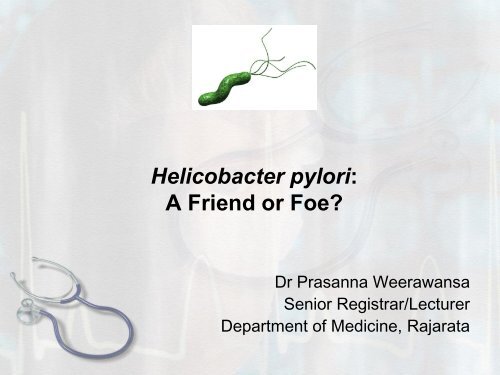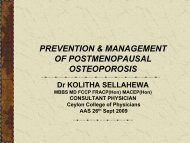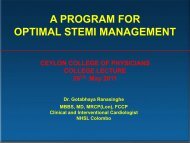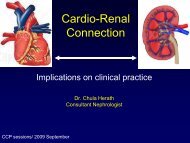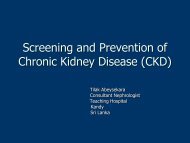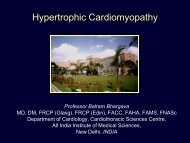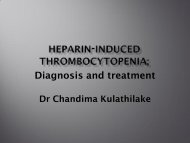H. pylori
H. pylori
H. pylori
Create successful ePaper yourself
Turn your PDF publications into a flip-book with our unique Google optimized e-Paper software.
Shortly after enactment, the California Notice Law was touted as likely to “create a de facto national disclosurepolicy” because of California’s “size and prominent role in the high-tech industry.” 9 And, indeed, ChoicePoint’scompliance with the notification requirements of the California Notice Law for California residents, and itsvoluntary provision of notice to all potentially affected consumers in other states, led to national media coverage ofits 2005 data security breach and a public outcry for similar legislation in other states. 10Since the California Notice Law has served as the prototype for other states’ data breach notification laws, followingis a brief summary of its requirements as they apply to persons or business entities: 11(1) Triggering Event For Disclosure: Any person or business entity that conducts business in California andthat owns or licenses unencrypted computerized data that includes “personal information” (hereinafter, the“Data Holder”) is required to disclose “any breach of the security of the system following discovery ornotification of the breach in the security of the data.” 12(2) Who Must Be Notified: All California residents whose “personal information was, or is reasonablybelieved to have been, acquired by an unauthorized person”. 13(3) Timing For Notification: Notification must be made “in the most expedient time possible and withoutunreasonable delay,” but delay is permitted until the Data Holder takes measures necessary to determinethe scope of the data breach. In addition, delay is permitted if a law enforcement agency determines thatnotification will impede a criminal investigation, but notice must then be given after the law enforcementagency determines that such action will not compromise the investigation. 14(4) Form & Types of “Personal Information” Covered: The only form of information protected by thenotification requirement is information maintained in unencrypted computerized format. The only types ofinformation protected are the following, but only if not otherwise publicly and legally available fromFederal, state or local government records:An individual’s first name or initial and last name in combination with one or more of the following dataelements:• social security number.• Driver’s license number or California Identification Card number.• Account, credit or debit card number in combination with any security or access code or passwordthat would permit access to an individual’s financial account. 15(5) Permitted Forms of Notice/Substitute Notice Triggers & Options: Written or electronic notice inaccordance with provisions of the Federal Electronic Signatures in Global and National Commerce Act(“E-Sign Act”) 16 is required in all circumstances, except that “substitute notice” is permitted if the DataHolder is able to demonstrate that:• The cost of providing the required written or electronic notice would exceed $250,000;• The number of persons that must be notified exceeds 500,000; or• The Data Holder does not have sufficient contact information on all affected persons to providewritten or electronic notice.When substitute notice is permitted, it must include all of the following:• E-mail notice when the Data Holder has an e-mail address for an affected person;• Conspicuous posting on the website of the Data Holder if one exists; and• Notice to major statewide media. 17(6) Required Content of Notice: None specified.
History• Late 1800‟s• G(-)ve bacteria in the stomach• 1970‟s• Visualization of bacteria in the stomach with GU• 1982• Dr. Barry Marshall & Dr. Robin Warren cultured the„spiral‟ shaped bacteria from gastric ulcer stomachs• Succeeded in visualizing colonies• Initially named as Campylobacter <strong>pylori</strong>• 1989• Gene sequencing done: Helicobacter genus created• Hĕlix/έλΙε̮‟spiral‟ or „coil‟• 2005• Dr. Barry Marshall & Dr. Robin Warren won the Nobelprize in Medicine
H.<strong>pylori</strong> and humans: an ancientrelationship cont..Evidence to prove the relationship• Genetic diversity among H. <strong>pylori</strong> strains decreases withdistance from East Africa, just like genetic diversity decreasesamong humans →• By comparing nucleotide sequences of different strains of H.<strong>pylori</strong> and measuring maximal in vivo mutation rates, it ispossible to calculate the minimal time that H. <strong>pylori</strong> & its hosthave shared a common ancestor: it is 58,000 years →• (Association of H. <strong>pylori</strong> enhances risk of gastric CA, adisease known since „Hippocrates‟)• Remnants of H. <strong>pylori</strong> have been discovered in gastric tissuefrom 700 years old Mexican mummy →
H. <strong>pylori</strong> adaptation to human colonization• Colonizes the stomach in childhood & persiststhroughout• Its spiral shape and flagella allow it to corkscrew throughthe gastric mucosal gel• Numerous adhesions enable selective adherence to thegastric epithelium• H. <strong>pylori</strong> has multiple mechanisms for protection againstgastric acid• 15% of its protein content comprises preformed cytoplasmicurease• It hydrolyses urea & releases ammonia• The ammonia neutralizes the periplasm and maintain thecytoplasmic membrane potential
Human immune response toH. <strong>pylori</strong>• H. <strong>pylori</strong> has evolved to minimize the stimulation of innateimmunity• H. <strong>pylori</strong> stimulate a humoral and cell-mediatedacquired immune response• Th response• ↑ Th 1 response & ↓ Th2 response• Treg response• ↑ immunosuppressive cytokines: IL-10, TGF-β• ↓ Epithelial cell IL-8 secretion & H. <strong>pylori</strong>-specific memory cellresponse
H.<strong>pylori</strong>-human interactions: in thepathogenesis of specific diseases
H. Pylori associated specific diseasesGastric adenocarcinoma (an ancient disease)• Predominantly a disease of old age• Arises in the context of pan- or corpus- predominantgastritis• Simple gastritis gastric atrophy metaplasia dysplasia carcinoma• The crucial step is atrophy• Removal of H.<strong>pylori</strong> before the development ofatrophy appears to prevent carcinogenesis
H. Pylori associated specific diseasescont..Gastric ulcers(a premodern disease)• Associated with H.<strong>pylori</strong>-induced pan- or corpuspredominantgastritis with normal or reduced acidlevels• Ulcers usually arise at the junction of the antral andcorpus mucosa (an area of intense inflammation)• Occurs in old age
H. Pylori associated specific diseasescont..Duodenal ulcers(a premodern disease)• Arise on a background of H. <strong>pylori</strong>- induced antralgastritis• Antral gastritis hyperigastrinaemia & high levels ofacid production from healthy gastric corpusgastricmetaplasia of the duodenum colonization byH. <strong>pylori</strong> inflammation & ulceration• Occurs in middle age
H. Pylori associated specific diseasesPeptic ulcer diseases ulcers are “premodern”diseases• Gastric ulcer disease• Arose in the 19 th century in the USA & Europe• Peaked in the early 20 th century• Duodenal ulcers• Arose and peaked 10-30 years later• Reasons for the emergence of peptic ulcer disease• Cigarette smoking?• Increased H.<strong>pylori</strong> virulence?• Changes in immunity?:impaired gastric mucosal Treg response
Smoking?↑H.<strong>pylori</strong> virulence?Change inimmunity?
H. Pylori associated specific diseasesOther H. <strong>pylori</strong>-associated diseases• Gastric lymphoma• Low-grade B cell lymphomas of MALT• Frequently regress following H. <strong>pylori</strong> eradication• Some cases of vit B12 & iron deficiency• ITP• Gastric atrophy ↓ IF↓B12 absorption• Gastric atrophy ↓gastric acidity↓iron absorption• Refractory ITP not responding to conventional therapiesmay show a response following H. <strong>pylori</strong> eradication• ? Risk factor for cardiac or thrombotic disease
Absence of H. <strong>pylori</strong>: A risk factor fordiseases?
Absence of H. <strong>pylori</strong>: A risk factor fordiseases?• H. <strong>pylori</strong>-• ?normal microbiota in humans• causes both physiologic & immunolgic changes• ?adapted physiology and immunology is normal• Human genetic constitution• may be based around the presence of HP?• Absence of H.<strong>pylori</strong>:• Is happening in many parts of the world• Improved living standards• Eradication therapy/antibiotic usage• some physiological & immunological changes takesplace for the first time in human history??
Is this recent change in homeostatic mechanismresponsible for some moderndiseases????????
Absence of H. <strong>pylori</strong> causeshyperchlorhydria GORD• H. <strong>pylori</strong> causes Pan/corpus gastritis• causes atrophy and hypochlorhydria• is more common & likely ancient: considered „normal‟ forhumans• Thus, H. <strong>pylori</strong> negative persons• Results abnormally high acid output• If these persons have• a hiatus hernia,• a lax lower oesophageal sphincter, or• increased transient lower oesophageal sphincter relaxationsgastroesophageal refluxate will be acidic leading toGORD
Absence of H. <strong>pylori</strong> causeshyperchlorhydria GORD cont..Is data available to fit this hypothesis?• H. <strong>pylori</strong> eradication in patients with corpus gastritisincreases acid production• ↓H. <strong>pylori</strong> prevalence in west: ↑GORD• East Asia pan gastritis common: ↓GORD• Following H. <strong>pylori</strong> eradication in East Asia, the GORDand oesophagitis have been increased
Absence of H. <strong>pylori</strong> : does thiscontribute to obesity…..?• Rise in obesity, metabolic diseases & DM have a similartime frame to the disappearance of H.<strong>pylori</strong> !
Absence of H. <strong>pylori</strong> : does thiscontribute to obesity…..?cont..• H. <strong>pylori</strong> colonization has specific effects on theGhrelin hormone• Serum Ghrelin• Discovered in 1999• Signals immediate hunger and appetite• Also a potent stimulator of Growth hormone• Gastric corpus produces 2/3 of the body‟s ghrelin• H.<strong>pylori</strong> colonization reduces Ghrelin-producing cellsin the stomach• H.<strong>pylori</strong> colonized patients have reduced serumGhrelin levels than non-colonized persons• (H. <strong>pylori</strong> eradication: ↑serum Ghrelin levels?)
Absence of H. <strong>pylori</strong> : does this contribute toobesity…..?cont..Evidences to suggest an association between H.<strong>pylori</strong>colonization and body habitus in children & adults• Growth of the children slows at the time of H.<strong>pylori</strong> acquisition &does not subsequently catch up to that in children not colonizedwith the bacterium• H.<strong>pylori</strong>-positive children tend to be shorter & lighter thannon-colonized children• H.<strong>pylori</strong>-positive adults in East Asia have a lower BMI than thosewho are non-colonized• East Asian studies show that H.<strong>pylori</strong> eradication leads to weightgain in adults
Absence of H. <strong>pylori</strong>: contributes to atopic &allergic disorders?• Hygiene hypothesis• Childhood exposure to infections aids maturation ofimmune response• Disappearing microbiota hypothesis• Protective agents are endogenous organisms thathave long been present in humans but aredisappearing
• Mechanism that could explain that the absence of H.<strong>pylori</strong>is associated with atopy/allergy• Reduced Th1 response increases Th2 response• Reduces/imbalance of Treg response
Thank you!
Acknowledgement• Dr. Mrs. Vajira Lekamwasam• Prof. Sarath Lekamwasam• Dr. Eisha Waidyarathna• Academic staff of Department of Medicine, Rajarata
References:1. Atherton J.C. and Blaser M. J. 2009. coadaptation of Helicobacter<strong>pylori</strong> and humans: ancient history, modern implications. J. Clin.Invest. 119: 2475-2487.2. Falush, D., et al. 2001. Recombination and mutation during longtermgastric colonization by Helicobacter <strong>pylori</strong>: estimates of clockrates, recombination size, and minimal age. Proc. Natl. Acad. Sci.U. S. A. 98:15056–15061.3. Linz, B., et al. 2007. An African origin for the intimate associationbetween humans and Helicobacter <strong>pylori</strong>. Nature. 445:915–918.4. Chidi V Nweneka and Andrew M Prentice. Helicobacter <strong>pylori</strong>infection and circulating ghrelin levels - A systematic review: BMCGastroenterology 2011, 11:7 doi:10.1186/1471-230X-11-7
humanHPLinz, B., et al. 2007. An African origin for the intimate association betweenhumans and Helicobacter <strong>pylori</strong>. Nature. 445:915–918.
Phylogeography of H.PyloriLinz, B., et al. 2007. An African origin for the intimate association betweenhumans and Helicobacter <strong>pylori</strong>. Nature. 445:915–918.


